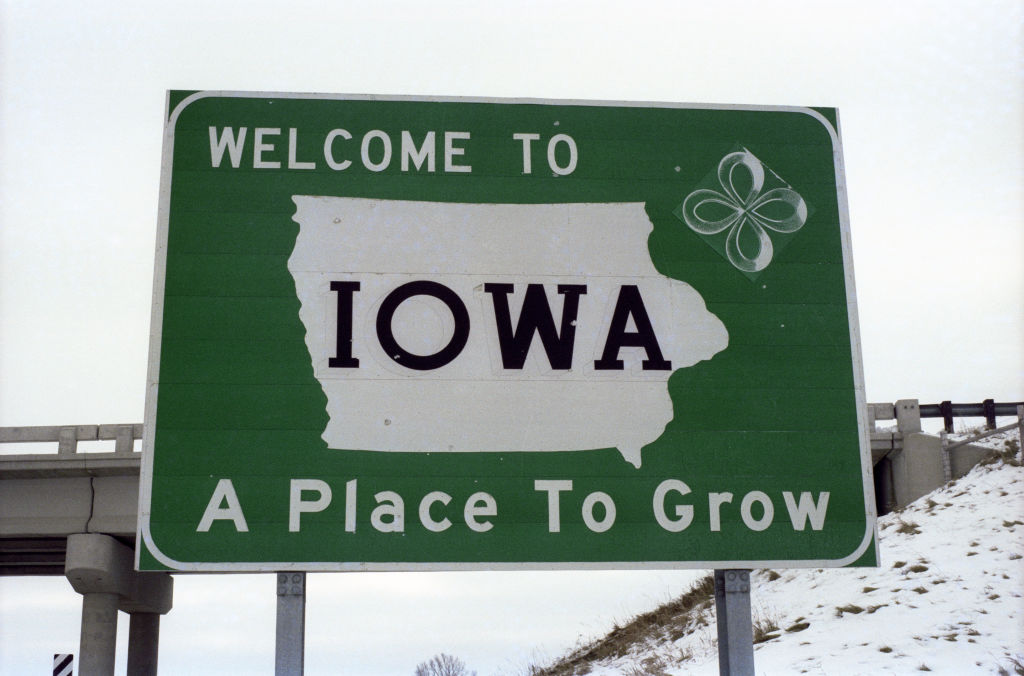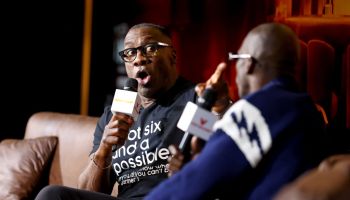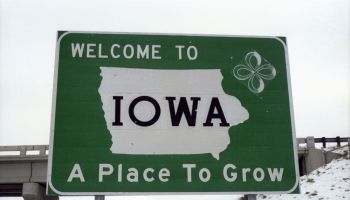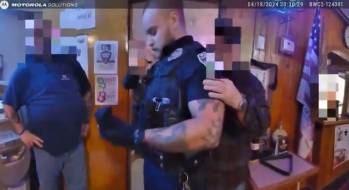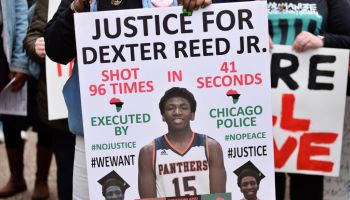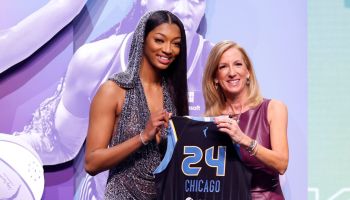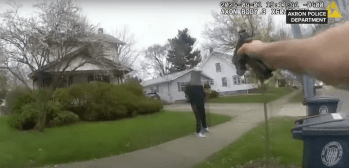An exclusive NewsOne IN DEPTH analysis
Dan Charnas is the Editorial Director of News & Information at InteractiveOne, and the author of “The Big Payback: The History of the Business of Hip-Hop” (New American Library/Penguin)
—————
If you aren’t a New Yorker of a certain age, as I am, it might be difficult to understand our dumbfounded reaction to the announcement last week that two legendary archrival Black radio stations — WBLS and 98.7 Kiss FM — would be “merging” into one; or, more accurately, 98.7 Kiss FM would be “celebrated” and then folded into WBLS.
MUST READ:
Iconic NY Black Radio Station Folds, 98.7 KISS Ends 30-Year Run
Radio Personality Michael Baisden Petitions to Get Radio Show on WBLS
David Hinkley of the New York Daily News likened it to the Yankees and the Mets laying down their bats and combining their rosters. But to me, it’s more like the United States absorbing the Soviet Union after a long, cold war. At times, the conflict between Kiss and ‘BLS was damn near thermonuclear.
In that heat, our culture was reshaped. And here is just some of the fallout:
- The birth of dance music as a genre; the rise and fall of disco
- The ascent of hip-hop
- The notion of the upscale Black consumer
- Multiculturalism as a marketing concept
For those who grew up in the Internet era — with radio no longer central to the American cultural experience — it’s hard to fathom that radio stations once had power to influence society in profound ways; and ridiculous that a mere ratings contest between two local radio stations could have global consequences. But it’s true.
Three decades have passed. And last week, both of these iconic radio stations found themselves on the brink of extinction.
WBLS’s parent company, the Black-owned Inner City Broadcasting, was being forced into bankruptcy by its investors. Kiss’s owner, Emmis Communications, had been selling off assets to stay solvent. Emmis’ finance chief, Patrick Walsh, saw the revenue of both of these stations plummet from $60 million a few years ago to $30 million.
Emmis’ president of radio, Rick Cummings, took a sober look at the situation.
“You had two stations that had once been dominant in the market battling each other down at 10th and 11th place,” Cummings said. “Neither of us were winning.”
To survive, one of them had to go. To many folks’ surprise, it was Kiss that went away.
“I really thought we would be the buyer for the longest time,” said Jeff Smulyan, founder and chief executive of Emmis.
On one level, the collapse of those two globally influential brands into one is a sign that radio’s power and value has been eclipsed, especially by new forms of media, downloadable and streaming music in particular. The troubles of radio were also compounded by deregulation — which made radio stations act according to the needs of the stock market rather than their audiences. And the woes of Black radio were redoubled by a new, digital audience measurement system, changing demographics, and the perennial racism of advertisers who — even in the 21st century — discount the buying power of the Black consumer. And the Great Recession of 2008 and 2009 just made everything worse.
But there’s more to it than that.
The fact is that the demise of 98.7 Kiss FM did not have to happen at all. Both Kiss and the station that swallowed it, WBLS, were sabotaged from within. Their swift rise and slow decline is the 30-year story of one of the greatest cultural and management failings of our time: How stations that purported to serve broad audiences with the power of Black culture ended up forgetting those audiences and ignoring that culture.
The squeezing of these once widely listened-to stations into a narrow lane called “Urban adult contemporary” has as much to do with the myopia of its programmers and sales force — perhaps a comfort with the world they know rather than fight it out in a world they don’t — as it does with economy, technology and demographics.
The history shows that both stations, year after year, made decisions that killed their stations’ future by fighting a cultural war against Black youth and by refusing to understand the broad appeal of the music they did program.
Story continues below…
Want to Keep Up With NewsOne.com? LIKE Us On Facebook!
Bill Stephney, a veteran radio programmer and former president of Def Jam Recordings, pointed to his own family as evidence of these stations’ irrelevance: “I have a wife who teaches teenagers. They don’t listen to music on the radio. I have two teenage sons who do not listen to music on the radio. I have a daughter who listens to music on the radio, but she likes Ke$ha, Katy Perry, Nicki Minaj, Brittany, all that stuff. So she’s not going to listen to [urban] stations.”
The younger urban artists like Chris Brown and Usher, Stephney said, sound more like electronic pop than soul music, leaving other stations open to take the Black youth market.
“[Kiss and WBLS] weren’t playing any of that stuff,” Stephney said. “So they really cut themselves in two ways. I always said that Black stations have the advantage. Instead of allowing the remaining relevant music stations to co-opt Black and dance music, it should have been the opposite. It should have been ‘BLS breaking music, wherever it came from, whether Justin Beiber or Justin Timberlake. They should have been up on that. Now you have an entire generation that doesn’t listen to these stations and doesn’t even think of radio as a listening option.”
Set aside youth for a minute. Even in serving adults, Stephney said, Kiss and WBLS didn’t really understand their legacy audience.
“If you were an 18-year-old fan of ‘Sucker MCs’ in 1983, you are now 47 years old. Yet, you were now unlikely to hear the song that changed New York Black radio some thirty years ago in gold rotation either on KISS or ‘BLS. The ‘adult contemporary, Urban station’ in 2012 still didn’t recognize that the anti-Hip Hop war was lost about 20 years ago.”
In other words, Kirk Franklin and Mary Mary are not legacy artists for people in their 30s and 40s. Biggie is.
Black radio stations, like any business, have the right to choose the constituencies they serve. But the conceit that you can represent a culture while denying a huge chunk of it is bankrupt. Writing off young people is tantamount to writing your own death sentence. And the idea on which these programmers based their business model — that Black culture is somehow “niche,” despite that fact that we live in a country whose pop culture is derived largely from Black culture — is laughable. Many businesses that serve core Black constituencies have found ways to prove their broad appeal: Russell Simmons did it with Def Jam. Jay-Z and Damon Dash did it with Rocawear, and Sean Combs with Sean John. And Emmis did it with Hot 97 in New York.
The irony of Kiss and ‘BLS is that these two stations practically invented the concept of the multicultural audience, the first to prove that Black-led stations could dominate diverse audiences with the power of Black culture. They were, despite their resistance, the first commercial stations to play hip-hop. The “tanning” or “browning” of America and the concept of a “Black planet”? Kiss and ‘BLS were among the first in media to attempt and succeed on those marketing models. They built the boat. They just didn’t get on it.
As the years went by, the management culture of both of these stations backed their properties into a cultural corner. While Black folks got bigger, Black radio got smaller. While Oprah conquered daytime TV and Barack Obama captured the White House, they allowed themselves to be limited.
98.7 Kiss FM and WBLS were essentially afraid to live in the Black planet they helped to create.
If this surprises you, it shouldn’t. To understand how this happened, one need only look back at the history.
Birth Of The “Black Liberation Station”
In the 1970s, WBLS was nothing short of a miracle.
It was one of the first Black-owned FM stations in the country, bought in 1974 by a group of Black businessmen from Harlem — a group that included Manhattan borough president Percy Sutton and future New York mayor David Dinkins. Sutton called his company Inner City Broadcasting.
The man they picked to run their newly acquired property, Frankie Crocker, was already a hero to New Yorkers of all colors. He had started as a DJ in the 1960s at WWRL, an AM station that served New York City’s burgeoning Black community, where Crocker was known for his smooth, slick between-song patter (“I’ll put a dip in your hip and a cut in your strut…”) — proto-rap that would be a direct inspiration to the generation of young New Yorkers who later invented hip-hop. Crocker’s overwhelming success at WWRL led to an offer from one of New York’s top pop stations, WMCA-AM, where he became the only Black DJ in the late 1960s.
Crocker remade WBLS in his own image, creating an eclectic playlist designed to blow his listeners’ minds. The core of WBLS was always R&B and soul, but Crocker often added jazz, rock, and pop standards to that mix. You might hear Sinatra right after Stevie, or the Stones after Sylvia Robinson. He was the first to play songs like Manu Dibango’s “Soul Makossa” — records that created the foundation of the dance music phenomenon that would become disco, and that made Crocker, the “Chief Rocker,” a celebrity on the disco scene. He also gave America some of the first exposure to an obscure Jamaican musician named Bob Marley. Crocker’s innovations and idiosyncrasies created an American singularity: At a time when radio was re-segregating along racial lines, Black artists were being purged from pop playlists, and Black radio stations left only scraps from advertisers, WBLS became the number one overall music station in the number one market in the United States.
The decisions that Frankie Crocker made had worldwide impact, determining not only which records would be hits, but what songs we would sing, what dances we would learn, which people would become stars, what ideas would be discussed. A Black programmer at a Black-owned station called all the shots.
A Crocker Fan Becomes An Enemy
By 1981, WBLS had long since trounced its competition. An FM station, WKTU, had taken a run at Crocker with an all-disco format. It won for a while, and then fizzled.
Only an arrogant fool, it seemed, could conceive of challenging Crocker and WBLS.
Barry Mayo was arrogant, for sure. In his job interview for an assistant programming position with WXLO, the flailing New York FM station owned by RKO General, the young Bronx native told general manager Lee Simonson to fire his program director and hire him instead.
But Mayo was nobody’s fool. He learned broadcasting at Howard University’s station, WHUR, and modernized a Black station in Chicago by using new business techniques like call-out research and focus groups. Mayo took the station, WGCI-FM, “from worst to first” in the ratings. He thought he could do the same for WXLO.
After Simonson hired Mayo, only one person stood in his way. Mayo, like most New Yorkers of his generation, had grown up idolizing Frankie Crocker. Shortly after taking the job, Mayo met Crocker face to face for the first time. Mayo complimented Crocker; Crocker blew a cloud of cigarette smoke in Mayo’s face. In that moment, Crocker transformed a fan into an enemy.
Building A “Black Top 40”
At noon on August 1, 1981, WXLO played a song called “Make That Move” by R&B group Shalimar to announce its own switch, to new call letters — WRKS — and to a new brand name, 98.7 Kiss FM.
Kiss was conceived as a “Black Top 40.” It would be hit driven, mounting a direct challenge to WBLS, whose programming was largely based on the wit and whim of Crocker. Mayo would achieve this, as he did in Chicago, through science: research and numbers.
“Kiss was more cohesive in what we stood for, musically,” Mayo reflected. “More consistent.”
Crocker’s WBLS was steeped in history. Mayo’s Kiss leaned toward the new. Crocker had relationships to the big power players in the music business. Mayo made new friendships with scrappy, local dance music labels like Profile and Prelude (whose artists Sharon Brown and D-Train, respectively, were signature Kiss-FM artists). Prelude Records, in fact, released a series of official “98.7 Kiss FM Mastermix” albums, produced by Shep Pettibone; albums that are a great tour through Kiss-FM’s musical ethos.
Said Mayo: “If I thought a record was a big hit and it didn’t fit WBLS, I would play the shit out of it, knowing he would either be late or he wouldn’t touch it.”
98.7 Kiss FM and WBLS served the same core audience: Black New Yorkers. But in the way they served their audience — WBLS by being musically eclectic, Kiss by being a bit more broad overall — both courted a larger constituency from the multicultural metropolis: progressive upper-middle class whites, outer borough European ethnic groups, Latinos. With a shared culture of fun, aspiration, sophistication and upward mobility — and with a format that elevated the “mastermix” as both a musical cornerstone and a demographic metaphor — both stations sought to transcend and blend racial and ethnic differences, the very definition of “cosmopolitan” or “urbane.”
Which was very close to the term that these stations actually came to use to describe their format and outlook: “Urban,” or “Urban Contemporary.”
The conventional wisdom is that Frankie Crocker coined the term. Barry Mayo insists that Lee Simonson first used it. Simonson said that he first heard the term from WRKS’s first radio consultant, Kent Burkhart. Burkhart isn’t sure about the origin of the phrase, either.
“I wonder if that term didn’t come out of a sales department somewhere,” said Burkhart.
Which would mean that the term may not have been derived to describe an innovative idea — that the acknowledgement and admiration of Black culture was a unifying principle for diverse urban audiences ready to leave racial and ethnic strife at the door to the disco. Rather, it was a euphemism created by radio sales people to subvert the racist perceptions of advertisers — that Black music and the stations that played it were for Black folks, and that Black folks didn’t have any money and thus weren’t worth courting as consumers. Better to call it something else.
This fallacy — and the game they played to deal with it — would plague both stations for their entire existence.
Humiliation And Retribution
In the early 1980s, 98.7 Kiss FM climbed in the ratings. But it still hadn’t beaten WBLS.
“It took longer than I thought it would take,” Mayo said.
WBLS had a “lock” on the concert promotions that were crucial to the positioning and revenue of radio stations. Mayo simply couldn’t find artists who’d be willing to align themselves with Kiss for fear of angering Crocker. But many folks in the music industry had tired of Crocker’s monopoly, and the abuse of power that came with it. When Barry Mayo was offered one of the hottest acts in the business — Rick James and Teena Marie — it was Kiss’s big break.
The concert at Madison Square Garden was packed. The “lips” logo of 98.7 Kiss FM hung everywhere. It was Mayo’s dream come true, until it turned into a nightmare — when, to Mayo’s slack-jawed shock, Frankie Crocker himself strode onstage and introduced the headline act.
A livid Mayo ran backstage, spotted Crocker — thronged by admirers — and mouthed the words that would change their lives:
I am going to get you, motherfucker.
The Turning Point
Hip-hop soon changed the balance of power between the two stations.
To be clear: Both men hated rap. Since the emergence of the first “rap” record in 1979 — “Rappers Delight” by the Sugar Hill Gang, Frankie Crocker had given airplay only grudgingly to the occasional single, and only then after it had exploded in the streets, clubs, and stores. When a DJ named “Mr. Magic” started attracting a sizable audience of young New Yorkers to his all-rap radio show on a small, community station called WHBI, Crocker co-opted him — giving him a weekend time slot on WBLS and a bigger audience than ever; but confining rap to Magic’s shift for the most part.
Over at 98.7 Kiss-FM, Barry Mayo fought constantly with his boy wonder music director, an Italian kid named Tony Quarterone, who insisted that Mayo’s own vaunted research showed that rap was becoming more and more the favorite of WRKS’s audience, with songs like “Planet Rock” and “The Message.” To Mayo, rap looked and sounded like disco’s bastard ghetto child.
And it was, until one day in 1983, Mayo played the record that forever divorced rap from disco.
He did it as a favor for a friend, a young promoter named Manny Bella who worked for Profile Records. Bella thrust forward the record by a strangely named group — “Run-D.M.C.” As the on-air jock played the song, “It’s Like That,” Mayo watched the phones light up. Then the DJ flipped the record and played the b-side, a song called “Sucker M.C.s.” Mayo absolutely hated what he was hearing: No music. Just a beat. And someone scratching a record. It sounded like… a mistake.
Then Mayo looked at the phones again. Pandemonium.
Mayo went against every musical and cultural instinct he had and put Run-D.M.C.’s first single into daytime rotation. Crocker didn’t. Mayo banged Run-D.M.C.’s record throughout the summer of [1984]. He hired the Zulu DJs to do a weekend rap show to rival that of Mr. Magic. He let Tony “Q” program more rap records during the day. And in the next ratings “book,” Barry Mayo achieved the impossible. 98.7 Kiss FM beat WBLS in the ratings.
Bill Stephney, who was at the time a college DJ on Long Island and would soon be head of radio promotion for Def Jam Recordings, spoke of the moment as a real turning point:
“Kiss beat ‘BLS in book after book. For two decades.”
WBLS and Frankie Crocker never really recovered.
Family Feud
Barry Mayo took to calling Frankie Crocker’s “hotline” immediately before the veteran DJ’s evening shift, just to taunt him.
“Frankie, I’m beating the shit out of you!” Mayo would say.
Crocker would then take to the air and warn his listeners not to listen to “that station with the lips,” and call Mayo “ugly” on air.
Crocker’s rap ambassador, Mr. Magic, took on his boss’s feud, labeling Zulu DJs Jazzy Jay and Red Alert as “Jazzy Wack” and “Red Dirt,” respectively. Magic told his audience to “smack that lipstick off your collar.”
Mayo loved it. Crocker and WBLS were essentially advertising 98.7 Kiss FM for free. And Mayo knew why the reaction was so irrational, so emotional. Behind the invective was a palpable sense of indignity and entitlement: WBLS was a Black-owned station; WRKS was not. Crocker himself was a cultural institution in the Black community; Mayo was not. It made the folks at Inner City Broadcasting cringe to think they could be beaten on their own turf by an essentially white-owned corporate entity.
“We used to ask the the question: ‘Who would you say does the best job of serving the needs of the Black community.’ When we started, [the answer] was overwhelmingly WBLS,” Mayo said. “We decided to actually fight on that front.”
While WBLS rested on its legacy, 98.7 Kiss FM went to work, going out into the community to do “Kiss Neighborhood Cleanups.”
The Kiss research showed that New Yorkers began to notice. But Kiss-FM’s emphasis on community service wasn’t entirely altruistic. Kiss-FM’s parent company, RKO General, was embroiled in litigation with the FCC, which was bent on revoking the entire RKO chain’s broadcast licenses after the parent company admitted to bribery and corporate misconduct.
“As a result,” Lee Simonson said, “we had to be purer than Caesar’s wife in terms of our community service commitment.”
The Generals Depart, The War Lives On
“I’ll give you a Mike Tyson analogy,” Mayo told me a few years ago during the research for my book, “The Big Payback: The History of the Business of Hip-Hop”. “The fight that changed his career forever was James Buster Douglas. This guy knocked him on his ass for the first time. He’d never been off of his feet before and he’s never been the same fighter. Frankie was the champ and after he got beat he didn’t know how to respond.”
The fates of the two fighters diverged. Barry Mayo was promoted to general manager of Kiss-FM. Frankie Crocker was fired.
But Mayo then extended the olive branch to Crocker: He offered him a job as Kiss-FM’s evening host in a meeting that, Mayo says, very few people know about.
“I remember going to his apartment on the East Side. We were drinking a bottle of red wine and talking about the possibility.”
But because of Crocker’s conviction on payola charges in the 1970s, and RKO’s desire to keep looking squeaky clean, RKO’s lawyers nixed Mayo’s idea.
Mayo left RKO shortly thereafter to start a new broadcast company with Lee Simonson. But even with Mayo and Crocker gone, the rivalry between the two stations persisted.
As it was before, the sloganeering was mostly one-sided, with WBLS urging its listeners to “Kiss off!”; they printed “Kissbusters” t-shirts and broadcasted “W-B-L-kickin’-S” promos.
The bad blood between Crocker and Mayo had long since infected their weekend rap DJs. WBLS’s Mr. Magic and his new lieutenant, Marley Marl, continued to go at Kiss-FM’s DJ Red Alert, often refusing to play records by Red Alert’s proteges. One of them, a rapper named KRS-One, tore into Magic’s entire stable of artists, who called themselves “The Juice Crew.”
War necessitates the invention of more powerful weapons. The antipathy between the two camps created a back-and-forth of lyrics and beats that literally changed the sound of hip-hop, with Marley on one side and KRS-One’s partner, Scott La Rock on the other, using powerful new “digital samplers” to lob sonic bombs across town.
Even groups not directly affiliated with the hostile parties were drawn into the conflict. When Bill Stephney’s own group at Def Jam, Public Enemy, handed Magic their first single, he dissed them on air: “No more music by the suckers,” he said.
Stephney’s partners, Chuck D. and Hank Shocklee, were so pissed off that they created a screeching retort. “Radio,” Chuck D. rhymed. “Suckers never play me.”
That record, “Rebel Without A Pause,” is considered a musical milestone, marking hip-hop’s entry into what some call its “Golden Era.”
Throughout all of this, most New Yorkers — rap fans or not — didn’t swear allegiance to either station. The war did, however, make for good theater, and even better music.
Kiss And ‘BLS Miss Their Chance
Even though rap had won the young audience for 98.7 Kiss FM; even though the war between the two stations’ rap shows fostered an explosion of creativity; neither Kiss nor WBLS would commit to playing hip-hop consistently. Rap was “dayparted” — played during the weekend “mix” shows and, if the requests and sales for particular songs were huge enough, sparingly in morning and evening “drive time.”
Despite their longstanding competition, the stations began to sound and look more alike, as they swapped executives, programmers, and air staff. And on the subject of rap music, the management of both stations seemed to be of the same mind: Keep it down. Program as little as possible. Both stations downplayed the popularity of hip-hop as a young, ghetto, male thing. Well before the rise of gangster rap, Black programmers were calling the following artists too “angry, too “ghetto”: De La Soul. Big Daddy Kane. Public Enemy. Jungle Brothers. MC Lyte. To the executives at Kiss and ‘BLS, hip-hop was dangerous, testosterone-laden music that stood in the way of their coveted adult female audience.
But the focus on adults, to folks like Bill Stephney and his boss at Def Jam, Russell Simmons, was beside the point. Simmons had admonished Barry Mayo before Mayo’s departure: Rap is not Black music. Rap is teen music.
Simmons and Stephney thought that Black radio could vanquish pop radio by using rap to go after white teens, who by dint of their numbers were buying most of the rap records sold in America anyway. “Yo! MTV Raps” was already the video channel’s highest rated show. Given this reality, Stephney saw Black radio’s resistance to hip-hop as not only as foolish, but suicidal. At a Black radio convention in 1988, Stephney ridiculed and scandalized the Black executives in attendance.
If you ignore the music of your people, he said in an acrimonious panel discussion, you will end up providing janitorial services for a white pop station.
Hip-Hop Finally Finds A Home
Bill Stephney was essentially warning that mainstream radio stations would discover that hip-hop was pop music before Black stations overcame their cultural resistance.
Stephney’s prediction proved to be correct.
In the late 1980s, a pop station in San Francisco, KMEL, had begun programming hip-hop aggressively in the daytime, when the crosstown Black station, KSOL, wouldn’t: groups like Public Enemy and X-Clan, Gangstarr and Digital Underground. Then, in 1992, Los Angeles station KPWR, called Power 106, began to emulate KMEL.
L.A.’s Power 106 was property of the same company that owned New York’s Hot 97 — Emmis Communications. Both stations, at the time, played a similar roster of Latin Freestyle artists for a young white and Latino audience. But when Emmis’ programming chief Rick Cummings saw Power’s ratings begin to tank, a little research revealed that Power’s audience had moved over to rap.
Cummings then did something that no programmer in pop radio had ever done. Instead of half-stepping it, disguising or “dayparting” hip-hop, he embraced the music wholesale, even in name. For the first time anywhere, a radio station branded itself with the term “hip-hop.” Power 106 became the place “Where Hip-Hop Lives,” trouncing its crosstown “Urban” competitor, 92.3 The Beat.
Cummings tried for a year to get the management of sister station, New York’s Hot 97, to follow suit. Hot’s program director Joel Salkowitz hired Funkmaster Flex to do a weekend show, but the station’s general manager, Judy Ellis, resisted. “We will never be able to sell hip-hop,” she told him. “It’s not going to happen.”
Ellis had good reason to think that Salkowitz and Cummings were nuts. Despite much evidence to the contrary, advertisers still viewed rap and hip-hop as having a primarily Black audience. And in the racist pseudo-science of American demography, Black audiences were viewed as having less worth than white audiences. As a result, Black radio stations earned something like 60 cents for every dollar that pop stations made. As KMEL had done in San Francisco, Power 106 had trained its sales staff to fight against those perceptions, and was beginning to win.
Ellis fired Salkowitz, and when the next programmer, Steve Smith, eventually came to the same conclusions as Cummings, Ellis dropped her resistance.
Smith took Power 106’s slogan, “Where Hip-Hop Lives,” more seriously than anyone expected. He put Funkmaster Flex on Hot 97 every day. He hired Dr. Dre & Ed Lover for his morning show. He sought the cultural counsel of respected MCs, and hired the founding fathers of hip-hop to do radio shows. Flavor Flav even did traffic reports. Community affairs shows guided listeners through riots and racial outrage.
Both Power 106 and Hot 97 quickly became the number one stations in L.A. and New York.
Just as WBLS had left the door open for 98.7 Kiss FM by neglecting the audience for rap, Kiss had then left that same door open for Hot 97. For hip-hop supporters like Bill Stephney, Black stations had only themselves to blame.
“They turned their back on the most significant development in Black music that had ever came out of New York,” he said.
As pop stations across the country began to adopt the Emmis formula, Black radio stations became followers in a game they very well could have led.
The Rebirth Of Kiss
In 1994, Emmis Communications bought 98.7 Kiss FM. With Hot 97 winning the youth audience, it allowed Kiss to jettison any pretense of competing for new ears with new music, and focus completely on adults and by programming old school R&B. Emmis hired celebrity talent from soul and funk’s glory days — Isaac Hayes, Ashford & Simpson, Roberta Flack — and created an expensive rebranding campaign.
“I still remember showing the Barry White commercial,” Cummings recalled. “He’s in this penthouse. He looks in the camera and says, as only he can, ‘98.7 Kiss FM… Ohhhhh baby.’ I got a standing ovation.”
The campaign triumphed for a time. 98.7 Kiss FM shot to #1, beating Hot 97 for the first time in years. WBLS trailed, a distant third.
The rivalry between WBLS and 98.7 Kiss FM heated up again. WBLS rehired Frankie Crocker for a spell, then fired him again. This time, WBLS’s on-air promo assault against Kiss took on explicit racial tones, labeling Kiss “the plantation station”: the white-owned station usurping the territory of the legacy Black-owned outlet.
Even the folks at WBLS knew it was bull. Crocker distanced himself from the plantation promos. WBLS morning man Ken Webb told the New York Times that the campaign was “childish.”
The Decline of Kiss
Emmis’s incarnation of 98.7 Kiss FM didn’t remain at number one. By 2001, its retro format had slumped badly in the ratings. That’s when Rick Cummings got a call from the station’s virtual father, Barry Mayo.
“Mr. Mayo,” Cummings answered. “To what do we deserve the honor of this call?”
“Rick,” Mayo replied. “Can I ask you a question? How did you fuck up my radio station?”
Cummings laughed. “Well,” he said. “We did.”
“In 26 years of my career,” Mayo continued. “I’ve never, ever made a phone call like this and asked this question: Can I help?”
In the years after he left 98.7 Kiss FM, Barry Mayo had sold his company and became a millionaire. Semi-retired, he went back to college, took photography courses and consulted radio stations in his spare time. But Mayo’s phone call with Cummings led, eventually, to Mayo’s re-entry into the radio business, as general manager of Emmis’s New York “cluster” of stations.
But Mayo found that the business he entered in the 1980s was not the same.
“It started with the signing of Telecommunications Act of 1996,” Mayo says. “The value of licenses started to escalate in anticipation of the industry being deregulated. And what you say a fundamental shift of the radio industry going from a predominantly broadcaster driven business to an investor driven business.” It made the running of radio stations subject to the weather patterns of the stock market, rather than the needs of individual stations and their audiences.
After Mayo’s departure from Emmis in 2006 to take the presidency of Radio One — a chain of Black-owned and -operated radio stations (that, by the way, owns NewsOne.com) — another huge change happened that would effect traditionally Black radio outlets in particular: The arrival of the Portable People Meter as a way to measure radio audiences. The digital device that listened and identified whenever a radio station was playing within human earshot replaced the manual “diaries” that, for decades, were the only way to determine how and when audiences listened.
The diaries relied on people’s memory and their perceptions, invariably influenced by their passions. And passionate audiences — Black listeners in particular — tended to overstate the amount of time they listened to their favorite stations.
Cummings elaborated: “They might think, ‘Oh, I love Steve Harvey! I never miss him. I listen from the time I get on the bus and get to midtown, so I listen for 90 minutes five times a week.’ And they would write that down.
“What they failed to note was that ‘On Tuesday I didn’t listen cause I was on the [subway], and on Thursday I didn’t listen at all.’ That’s what happens when you’ve got very loyal people. I don’t think they were [at another station]. They were just nowhere.”
The advent of the Portable People Meter in 2007 and the Great Recession in 2008 packed a one-two punch to Black radio.
“We knew that you were only going to have [room for] one urban station in New York,” said Emmis founder and chief executive, Jeff Smulyan.
The only question was: Which one would it be?
The Endgame
In early 2012, while WBLS fell into the custody of investors Yucaipa-Magic-Fortress (an alliance forged by billionaire Ron Burkle and Magic Johnson), Emmis Communications’ 98.7 Kiss FM continued to struggle.
Then executives at ESPN approached Emmis about leasing the 98.7 FM frequency for a sports talk station.
Emmis’s Smulyan saw the overture as an opportunity to resolve his urban conundrum: Use the money from the lease of the Kiss frequency to buy WBLS, creating one powerful and more profitable urban station.
Smulyan began negotiations with Yucaipa-Magic-Fortress, who effectively controlled the fate of WBLS by this point.
“We really felt that we were by far the best buyer,” Smulyan said. “But they kept holding out for a price that just didn’t make any sense to us.”
Patrick Walsh explained: “We began to get somewhat concerned that the longer our process dragged on, that ESPN would take their money and go find another [frequency].” Perhaps that frequency would be that of WBLS.
Smulyan added: “We said, ‘Do we really want to turn ourselves upside down to get more debt? Maybe we should play the other side of this hand.’”
So Smulyan and Walsh made the custodians of WBLS a offer: If you pay us to go away, we’ll take the ESPN deal. You’ll have a profitable, top five station as a result. If you don’t, we may continue to fight it out with you.
WBLS executives eyed the proposal shrewdly. Even if 98.7 Kiss FM failed in that battle, Kiss’s listeners might not simply flock to WBLS. What Emmis was offering, in effect, was help in shepherding its current audience into the arms of WBLS by selling the “intellectual property” of the station — its brand, logo, trademarks, archives and, if need be, its staff. Which meant that WBLS would be purchasing something even more important: insurance that the 98.7 Kiss FM brand could never be resurrected to threaten it again.
Deon Levingston, the vice president and general manager of WBLS, had done these kinds of IP deals before. In fact, his first came when Levingston was an Emmis employee back in 2000, working out of the company’s headquarters in Indianapolis, when Emmis sold the intellectual property rights of a viable, popular brand, WTLC-AM and -FM, to Radio One; a successful transaction that effectively preserved the audience of a heritage station. Levinsgton hoped that WBLS could do the same with its rival’s audience.
As the deal became real last week, Levingston was in a daze: “I’ve been involved this day-to-day Kiss-‘BLS battle for eight years now,” he said. A 30-year-war now drawing to a close.
Many of the people he fought at Kiss were former colleagues from his Emmis days; now Levingston found himself negotiating with them. A few of his current employees at WBLS were, like him, Emmis alumni. Some Kiss employees — staff, air talent — would likely come work for him. Most would not.
The mood in the rooms where the former adversaries met to finalize the details — a weekend-long simulcast, the restructuring of air staff rosters, the linking of the Kiss and WBLS websites — was one of gravity, not elation. There was no gloating, as Barry Mayo did at a music industry function decades earlier, publicly thanking Crocker for all his anti-Kiss rhetoric. “Without you, we never could have gone to number one,” Mayo had proclaimed, while the audience roared.
Instead, the proceedings were somber. “There was no celebration like ‘Hey, we finally got Kiss out of the way,’” said Cummings. “We were talking about two heritage brands coming together with one voice.
Cummings says he “got kind of emotional” going through the Kiss archives in preparation for the simulcast. “It was a really painful day. Our listeners are just absolutely devastated. What has made me feel better is the spirit of the folks over at Inner City. We thought they were saying the right things. But they are actually doing all the right things.”
“It’s all been very surreal,” said WRKS GM Alex Cameron. “It’s very difficult. I cant help but feel for the folks who worked here. We are keeping very few people because financially we can’t support it. WBLS is going to be interviewing all of our employees.”
Cameron said that while WBLS has confirmed only two Kiss jocks in their lineup — Shaila and Lenny Green — they may be considering other Kiss icons like Red Alert and Bob Slade. WBLS is keeping the syndicated Steve Harvey show in its morning slot. Kiss’s similar arrangement with the Tom Joyner morning show has been jettisoned.
Emmis will use the money from the selling both the lease on the 98.7 FM frequency and the intellectual property of the Kiss brand — almost $100 million — to pay down a significant portion of its debt.
Though the past week has been filled with the surreal coupling of those two logos, WBLS has now kissed those lips goodbye.
“After we celebrate the Kiss brand,” Levingston said, “we will market the WBLS brand to the former Kiss listeners.”
The simulcast of WBLS and WRKS has ended, the Kiss website now redirects to WBLS, where the Kiss logos have been scrubbed.
WBLS now reigns as the only adult urban station in New York.
What We’ve Lost
Barry Mayo, who recently left the presidency of Radio One, was in the middle of a trip to Canada when heard of the deal to end the life of the station he cofounded.
“I felt a little sad,” he said. “I can’t help but be melancholy. I helped build that station.”
Mayo’s old adversary, Frankie Crocker, died of cancer in 2000.
“If Frankie were alive, and he called me today and said ‘Barry, can you believe that shit?’ He and I would be somewhere tonight, drinking a bottle of red wine, telling lies and doing revisionist history of our battles.” And here Mayo leaves the language of radio and invokes the language of the Internet: “S.M.H. Shaking our heads.
“But I can’t wax too philosophical,” Mayo concluded, “because the industry that Kiss entered on August 1, 1981 is not the same.”
Neither is the world. The sorrow of this moment is wrapped up in the idea that a number of things are forever gone.
For New Yorkers of that certain age, it is the passing of the city they once knew. The core Black audience that had Southern roots, the ones who brought R&B and soul and funk north with them — those folks are gone. Gone too are those first wave of Puerto Rican immigrants who cocreated hip-hop with the sons and daughters of Black southerners, and with them that particular Spanish-inflected “Noo Yoawk” accent that graces much of that music. Gone is the hip-hop that once sounded so threatening to some and to others, worth fighting for; music that now feels so quaint. Weakened is the demographic power of those constituencies that once elected a Black mayor, WBLS investor David Dinkins.
That New York can no longer support two urban stations — as it still supports two baseball, two football, and two basketball franchises — can leave those who identified with those stations feeling diminished.
But New York — and a new generation of New Yorkers — live on. That 98.7 Kiss FM ceased to understand and serve them is the real reason that the venerable brand is now history.
Dan Charnas is the Editorial Director of News & Information at InteractiveOne, and the author of “The Big Payback: The History of the Business of Hip-Hop” (New American Library/Penguin)
MUST READ:
Iconic NY Black Radio Station Folds, 98.7 KISS Ends 30-Year Run
Radio Personality Michael Baisden Petitions to Get Radio Show on WBLS
